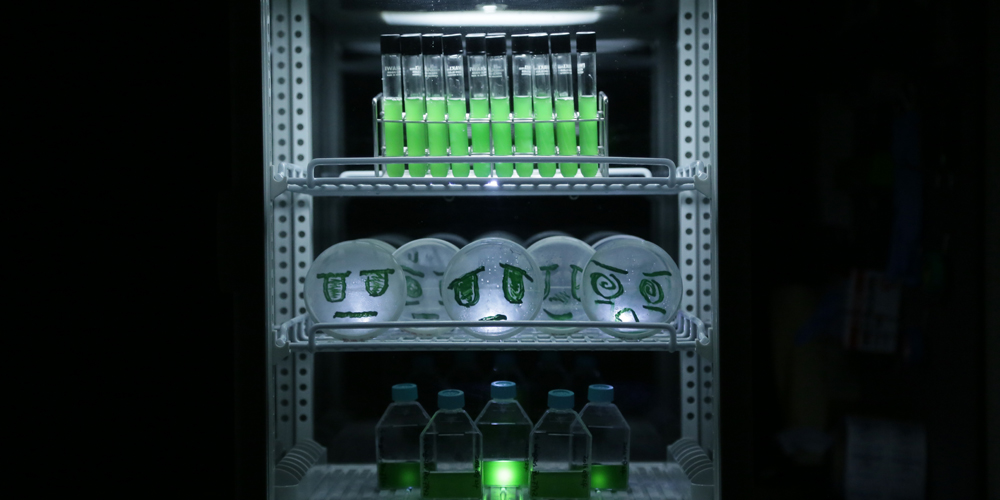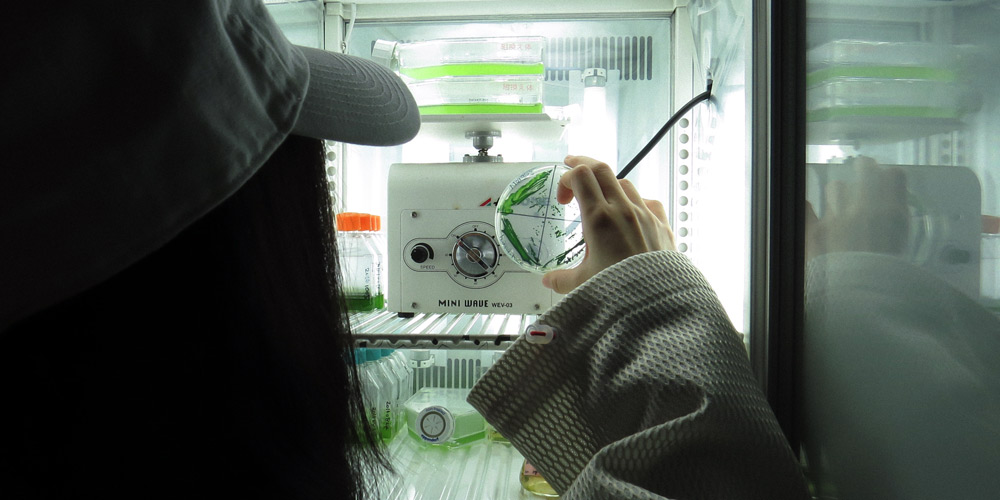
Credit: MIRAI records, foto: MIRAI seisaku
Etsuko Yakushimaru (JP)
The project l’m Humanity is based on the concept of “post-humanity music” and explores how new music will be transmitted, recorded, mutated, and diffused whether sung or played via word of mouth, as scores, through radio, records and CDs, or cloud computing.
Music travels through space and time, undergoing mutations on its way. The close connection between music and media is like that between transmission and recording, and can be thought of as genes and DNA. As a musician, Yakushimaru has worked in a variety of genres from pop to experimental music and has created various types of artwork such as drawings, installations, pieces that make use of satellite and biometric data, a song-generating robot, original instruments, and more.
In l’m Humanity, Yakushimaru makes pop music with the use of the nucleic acid sequence of Synechococcus, which is a type of cyanobacteria. The musical information is converted into a genetic code, which was used to create a long DNA sequence comprising three con-nected nucleic acid sequences. The DNA was artificially composited and incorporated into the chromosomes of the microorganism. This genetically-modified microorganism with mu-sic in its DNA is able to continuously self-replicate. So even if humanity as we know it becomes extinct, it will live on, waiting for the music within it to be decoded and played by the species that replaces humanity.
When thinking about the lifespan of recording media, for example, CDs are said to last for decades and acid-free paper is said to last for centuries. In comparison, DNA’s lifespan as a recording media is 500 thousand years, physicochemically speaking. Because the lifespan of DNA is so long, it has great potential as a recording media.
Biotechnical procedures
In our DNA, which consists of four kinds of nucleotides (A, C, G and T), each amino acid is encoded into a distinct nucleotide triplet. The rules for translation are summarized in the codon table. A cipher to convert the music chords into genetic codes was created based on this codon table used in living cells. The main chord progression of I’m Humanity was converted into the following 276 nucleotides:
I’m Humanity: 276bp; A 22; T 101; G 57; C; 96 (GC content = 55.4%)
GGTCTTCCCCATGGTCTTCCCCATGGTCTTCCCCATGGTCTTCCCCATGGTCTTCCCCATGG TCTTCCCCATGGTCTTCCCCATGGTCTTCCCCATTCTTCTGGAGGATCTTCTGGAGGATCTTCTTT-GGGTTCTTCTGGAGGCGGTCTTCCCCATGGTCTTCCCCATCTTCTTCTTCTTGGTGGTGGTGG-TATTCTTCTTCTCGGTGGTCCCAC-TGGTCTTCCCCATGGTCTTCCCCATGGTCTTCCCCATGGTCTTCCCCATGGTCTTCCCCAT
The genetic code was artificially synthesized by a DNA synthesizer and inserted in a vector, designated pSyn_1. The inserted DNA fragment encoded music chords was introduced to a genome of a host cell (a cyanobacterium, Synechococcus elongatus PCC 7942) by homolo-gous recombination. The music chords in the Synechococcus genome can be infinitely re-produced along with cell division.

“I’m Humanity” genetically-modified microorganism

Etsuko Yakushimaru with “I’m Humanity” in culture
On the other hand, it is not rare for nucleic acid sequences to mutate, and naturally this leads to changes in the genetic information. In that respect, in the history of “diffusion of music,” in which “mutation” has also had an important role in addition to “transmission” of information, the uniqueness of the “mutation” of nucleic acid sequences was strikingly similar.
In the lyrics of I’m Humanity, the microorganism I’m Humanity sings “Stop the evolution―don’t stop it.” Although mutation spurs evolution, it also means the changing of a species. Perhaps I’m Humanity is caught between its own evolution and its fear that its evolving could mean the loss of nucleic acid sequences with musical information, which would make it impossible for I’m Humanity to sing the song anymore.
The transposon (the genes that transfer on the genome and cause mutation) based on the DNA of Synechococcus, was planted in the score of “I’m Humanity”. In this performance, that segment was performed in an arragement to make it seem like actual mutatuin was taking place.
I’m Humanity became the first song in human history to be released in the three formats of “digital music distribution,” “CD,” and “genetically-modified microorganism.” This song, produced with the use of biotechnology, was distributed as pop music and also made it on the Apple Music start page.
Credits
l’m Humanity produced and directed by Etsuko Yakushimaru
Lyrics: Tica Alpha (a.k.a Etsuko Yakushimaru)
Music: Tica Alpha (a.k.a Etsuko Yakushimaru)
Genetic Codes: Etsuko Yakushimaru
Art Direction & Drawing & Design: Etsuko Yakushimaru
(C) 2016 Yakushimaru Etsuko
Musical arrangement: Etsuko Yakushimaru, Motoki Yamaguchi
Vocal & Chorus & Programming & dimtakt: Etsuko Yakushimaru
Drums & Programming: Motoki Yamaguchi
Recording & Mixing Engineer: Yujiro Yonetsu
Mastering Engineer: Shigeo Miyamoto
Technical Support: Satoshi Hanada
Photograph & Movie: MIRAI seisaku / Photograph(Compact Disc): Satomi Haraguchi
Label: MIRAI records
(P) MIRAI records
Support & Thanks: KENPOKU ART 2016, METI Ministry of Economy, Trade and lndustry., National Institute of Technology and Evaluation (NITE), Satoshi Hanada, Tokyo Metropolitan University, FabCafe MTRL, Yamaguchi Center for Arts and Media [YCAM]
*Apple Music is a trademark of Apple Inc., registered in the U.S. and other countries.
About the artist
Etsuko Yakushimaru (JP) is an artist, musician, producer, lyricist, composer, arranger, and vocalist. Broadly active, from pop music to experimental music and art. Consistently independent in her wide-ranging activities, which also include drawing, installation art, media art, poetry and other literature, and recitation. Producing numerous projects and artists, including her band, Soutaiseiriron. While appearing in the music charts with many hit songs, she has also created a project that involved the use of satellite, biological data and biotechnology, a song-generating robot powered by artificial intelligence and her own voice, an independently-developed VR system, and original electronic musical instruments. Major recent activities include exhibitions at Mari Art Museum, Toyota Municipal Museum of Art, KENPOKU ART 2016, and Yamaguchi Center for Arts and Media [YCAM]. Her Tensei Jingle and Flying Tentacles albums, both released in 2016, received praise from figures including Ryuichi Sakamoto, Jeff Mills, Fennesz, Penguin Cafe, Kiyoshi Kurosawa and Toh EnJoe.
Read more: starts-prize.aec.at.
This project is presented in the framework of the STARTS Prize 2017. STARTS Prize received funding from the European Union’s Horizon 2020 research and innovation programme under grant agreement No 732019.
![]()

